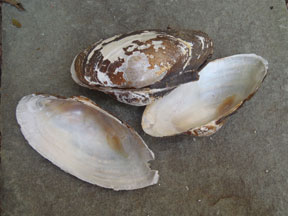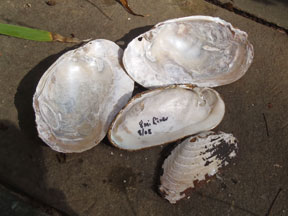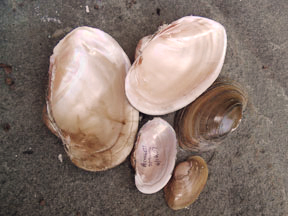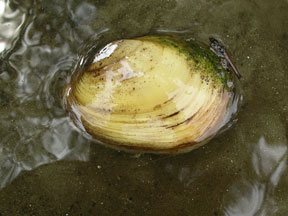
Our Mission: The Mattabeseck Audubon Society, a chapter of the National Audubon
Society, is committed to environmental leadership and education for
the benefit of the community and the earth's biodiversity.
deKoven House,
27 Washington Street,
Middletown, Connecticut 06457
Please do not collect living specimens, as some may be endangered.
KEY

Here are some images of our local mussel species
| Species | Image |
Alewife Floater Often the largest mussel shells you'll find, these sturdy mussels are found in mud and sand substrates. They have a brown periocostracum usually worn off at the beak, and the interior is somewhat thick to thin. The thin areas are bluish-white and the thicker parts often have some salmon tint. Hinge is very small and thin. |
 |
Eastern Elliptio Our most common mussel, and found in many substrates, this species is quite variable. Older specimens have black to brown pericostracum with white to pinkish nacre. Older shells may have bottom "banana" curve. Very young specimens may have a purplish nacre, and their smooth periocostracum may be greenish or tan or dark, and may sometimes have bands and/or rays. Shape is elongated and laterally flattened. (The flatness is distinctive.) Has strong hinges. |
 |
Eastern Floater These medium to large-size shells are characteristically thin and fragile. Their nacre is white to bluish-white and luminous. Periocostracum is banded and usually somewhat greenish. (Some shells are very green, others are a greenish brown to tan/brown.) They will have a very thin hinge. Found in sand and mud. |
 |
Eastern Lampmussel Vertical rays help to distinguish this species from the rather similar Elliptio—the Eastern Lampmussels will have strong rays and bands, and they are more inflated in shape than Elliptios. Nacre will usually be strong pink to a pink-tinged white. Note the somewhat thickened anterior end. It is usually more pink that rest of interior. Strong hinge. |
 |
Eastern Pearlshell Found only in fast-moving rocky streams, the living specimens have very dark pericostracum and can be difficult to spot—usually only the anterior end sticks up and looks very like a rock. Shells are moderately inflated with a distinct banana-shaped curve at bottom. Identified by their row of "shots"— tiny divets in a line on shell interior. Nacre is extremely luminous white (hence the "pearlshell" name). Shells can be quite large with a strong hinge. |
 |
Eastern Pond Mussel Look for the dark near-black periocostracum and elongated shape. These shells are seldom more than 4" in length, and are found in sand and mud substrates in moving water as well as in ponds (despite their name). Nacre is bluish/purplish and quite luminous. The rather sharp and extended point on the posterior end distinguishes this species. Strong hinge. |
 |
Triangle Floater Identifying feature: interior has very thick anterior, very thin posterior, with a rather distinct demarcation between the thicknesses. Their dark periocostracum is usually worn off at the beak. Laterally inflated and usually shaped like a triangle with rounded corners, these mussels can be found in many habitats, but they are less common than other species. Seldom more than 3", small hinge, white nacre. |
 |
Tidewater Mucket Shape is quite inflated. Nacre is very salmon-pink. Brown-banded periocostracum will be characteristically rough in older specimens but very smooth in juveniles. Shells may be quite large and will be moderately thick. Moderately strong hinge. Quite rounded and laterally inflated, but not as round or as inflated as the Yellow Lampmussel. (Shell may look like a big pink ear.) |
 |
Yellow Lampmussel This "Species of Special Concern" is still very uncommon in Connecticut, but it is on the rise. It was believed extirpated in our state for about 50 years, until seen again in 2010. Found in clean water with sandy/silty bottoms, it's similar to the Mucket in shape, but rounder and more inflated. Pericostracum is distinctly pale lemon-yellow, especially in younger specimens. Nacre is white without any pink or salmon tint. Live specimens often sport a green algae beard on the posterior edge. Strong hinge. |
 |
Why you sometimes see lots of mussel shells in one place? Otters and muskrats hunt and eat mussels, and carry their catch to a midden area to open and eat them.
|
On average, how many mussel species will be present in any single location? Depends on the location. Along the Connecticut River, you'll usually find Elliptio, Eastern Lampmussel, Tidewater Mucket, and Alewife Floater. If sandy and clean substrate is nearby, add Eastern Pond Mussel. Eastern Floater is a little less common. Triangle Floater is even less common. Eastern Pearlshell is found only in fast-moving water in small rivers and streams (not in the Connecticut River here in Connecticut.) Yellow Lampmussel is still very rare. |